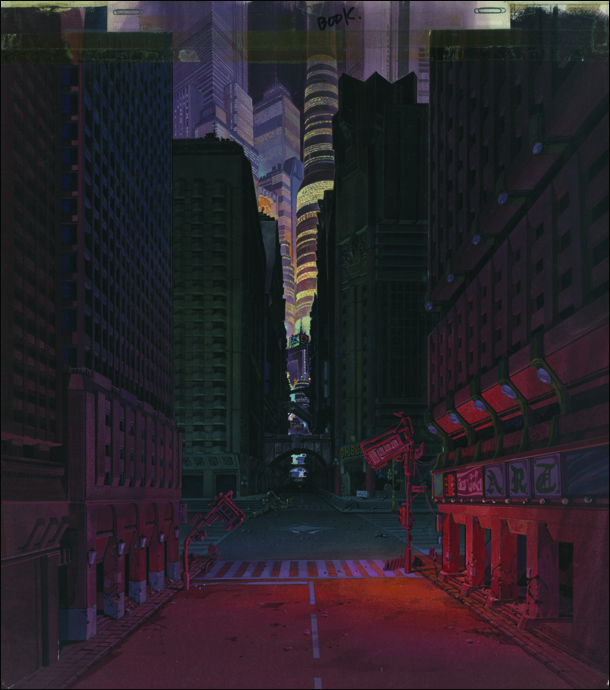 For the last couple of decades, anime has been influencing cinema, literature, comic books, and video slots games, all around the world, by breathing a new lease of life into the art of storytelling, be it through the depiction of futuristic cities made of steel and glass, or romantic rural locales full of love and hope. Heck, anime has become so influential, both visually and contextually, that my mates over at Thames & Hudson have decided to publish a book explaining how it's affected the wonderful world of architecture. Want to know more? Then please check out the following image gallery that features some of the atmospheric pictures seen inside...
For the last couple of decades, anime has been influencing cinema, literature, comic books, and video slots games, all around the world, by breathing a new lease of life into the art of storytelling, be it through the depiction of futuristic cities made of steel and glass, or romantic rural locales full of love and hope. Heck, anime has become so influential, both visually and contextually, that my mates over at Thames & Hudson have decided to publish a book explaining how it's affected the wonderful world of architecture. Want to know more? Then please check out the following image gallery that features some of the atmospheric pictures seen inside...Anime Architecture: Imagined Worlds and Endless Megacities
(18) Akira / Cut no. 1
Still image
Based on the
graphic novel AKIRA by Katsuhiro Otomo. First published by Young Magazine,
Kodansha Ltd. © 1988 MASH • ROOM / AKIRA COMMITTEE All Rights Reserved
(72) Patlabor 2: The Movie / Cut no. 572
Final
production background for the Hiromasa Ogura Poster
© 1993 Headgear
(126) Ghost in the Shell / Cut no. 239
Final
production background for the Shuichi Kusamori Poster
© 1995 Shirow Masamune / KODANSHA • BANDAI VISUAL • MANGA
ENTERTAINMENT. All Rights Reserved
(153) Metropolis / Scene 12 / Cut no. 7
Final
production background for the Shuichi Kusamori Poster
© 2001 TEZUKA PRODUCTIONS / METROPOLIS COMMITTEE. Licensed
from BANDAI NAMCO Arts Inc. All Rights Reserved
(48) Akira / Cut no. 426
Final production
background by an unknown artist
Based on the graphic novel AKIRA by Katsuhiro Otomo. First published by Young
Magazine, Kodansha Ltd. © 1988 MASH • ROOM / AKIRA COMMITTEE All
Rights Reserved
(60) Patlabor: The Movie / Cut no. 186
Final
production background for the Hiromasa Ogura Poster
© 1989 Headgear
(134) Ghost in the Shell / Cut no. 509
Final production background for the Hiromasa Ogura Poster
© 1995 Shirow Masamune / KODANSHA • BANDAI VISUAL • MANGA ENTERTAINMENT. All Rights Reserved
(39) Akira / Cut no. 207
Final production
background for the Toshiharu Mizutani Poster
Based on the graphic novel AKIRA by Katsuhiro Otomo. First published by
Young Magazine, Kodansha Ltd. © 1988 MASH • ROOM / AKIRA COMMITTEE All
Rights Reserved
(58) Patlabor: The Movie / Cut no. 182
Final
production background for the Hiromasa Ogura Poster
© 1989 Headgear
Author: Stefan Riekeles
Publisher: Thames & Hudson
Price: £35
Format: Quarterbound (no jacket) Size: 28.0x21.5cm
Number of Pages: 256 pages and 400 illustrations
Synopsis: This lavish book allows us to have a look at the fantastic environments created by some of the most important and revered directors and illustrators from Japanese animated cinema, such as Hideaki Anno, Koji Morimoto, and Mamoru Oshii, to name but a few. It also gives us the opportunity to access several studio archives housing things like, original background paintings, storyboards, drafts, and film excerpts, so we can see how certain productions are gradually developed for the silver screen, starting from the earliest stages of conception all the way up to the numerous scenes featured in the final film, including scenes from Akira, Ghost in the Shell, Metropolis, and more. So, if you’re a fan of art, architecture, or anime, then I'd say this book is most definitely the book for you.
About the Author: Stefan Riekeles is a curator from Berlin, Germany, who mainly works in the field of art. In 2010, he served as the Programme Director for the ‘International Symposium on Electronic Art’ (Essen), and then in 2011, he served as the Artistic Director for the ‘Japan Media Arts Festival’ (Dortmund). He’s also curated for a number of notable exhibitions associated with anime, such as the ‘Transmediale Festival’ (for art and digital culture), ‘Proto Anime Cut’, and many, many, more. Currently, he holds an MA in ‘Culture Studies and Audio Communication Science’ from the Humboldt University and the Technical University in Berlin.
For further information, please feel free to check out the official Thames & Hudson Website, Facebook, and Twitter pages. Or better yet, why not pop on over to Stefan’s Website to see what else he has in store.
ANIME ARCHITECTURE: IMAGINED WORLDS AND ENDLESS MEGACITIES
 Reviewed by David Andrews
on
December 28, 2020
Rating:
Reviewed by David Andrews
on
December 28, 2020
Rating:
 Reviewed by David Andrews
on
December 28, 2020
Rating:
Reviewed by David Andrews
on
December 28, 2020
Rating:

















No comments: